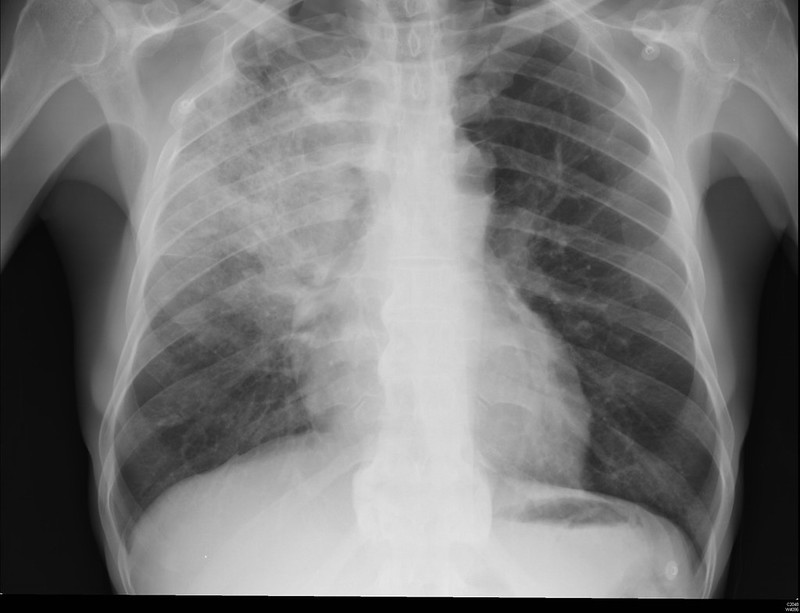By: Kelsey Toups
Image courtesy of Dr. Yale Rosen Atlas of Pulmonary Pathology; CC-BY-SA 2.0
White lung syndrome isn’t a recognized medical condition; rather, it’s a term used for pneumonia distinguished by lung whitening on x-rays [1]. Health officials in Ohio and Massachusetts, where there have been increasing pediatric pneumonia cases, in addition to CDC director, Mandy Cohen, state that the cause of these cases is not a novel pathogen and are caused by the typical COVID, flu, RSV, and mycoplasma pathogens [1,2,3]. Similarly the Chinese ministry of health attributes the outbreak in China to known pathogens: influenza, rhinoviruses, and mycoplasma.
Mycoplasma pneumoniae are bacteria that damage the lining of the respiratory system, sometimes causing pneumonia. M. pneumoniae infections are common in the U.S. The CDC reports that the disease peaks every 3 to 7 years, with about 2 million cases reported every year in the U.S.[4]. This bacteria is spread when an infected individual coughs or sneezes and someone inhales those droplets. Because prolonged contact with a sick individual increases the risk of contracting this illness, most cases are spread between households. Most outbreaks of this illness are found in congested settings like schools, residence halls, and hospitals.
Symptoms of Mycoplasma pneumoniae vary based on the type of infection, but they are usually mild. Common symptoms include those of chest colds or head colds including fever, sore throat, cough, and headache. This bacteria can also cause pneumonia, with symptoms such as cough, fever, malaise, and shortness of breath. This type of infection is treated with antibiotics. Aside from people who live or work in crowded settings mentioned above, people are also at an increased risk for serious infection if they are recovering from a respiratory illness or have a weakened immune system [4].
Although the increase in respiratory infections is common this time of year and shouldn’t overly concern parents, health officials advise them to take extra precautions. This includes measures like frequent handwashing, keeping sick children at home, and practicing basic hygiene such as using tissues when sneezing and disposing of them properly [1,4]. Ensuring that children are up to date on flu, COVID, and RSV vaccinations is also essential in protecting them from these infections that may lead to pneumonia.
White Lung Syndrome emerges not as a new disease but rather as a descriptive term for pneumonia. The surge in pediatric pneumonia cases in Ohio, Massachusetts, and China is attributed to familiar pathogens like COVID, flu, RSV, and mycoplasma, rejecting any idea of an unknown pathogen. While cases are on the rise, this is not atypical for these diseases in the colder season. As we continue to navigate the challenges of respiratory infections, informed precautions remain crucial for protecting public health.
References:
- https://www.nbcboston.com/news/local/what-to-know-about-so-called-white-lung-syndrome-in-mass/3207544/
- https://www.cbsnews.com/news/ohio-white-lung-pneumonia-not-linked-to-china-outbreak-novel-pathogen-experts/
- https://www.independent.co.uk/news/health/white-lung-syndrome-ohio-china-pneumonia-b2458546.html
- https://www.cdc.gov/pneumonia/atypical/mycoplasma/about/history-patterns.html


